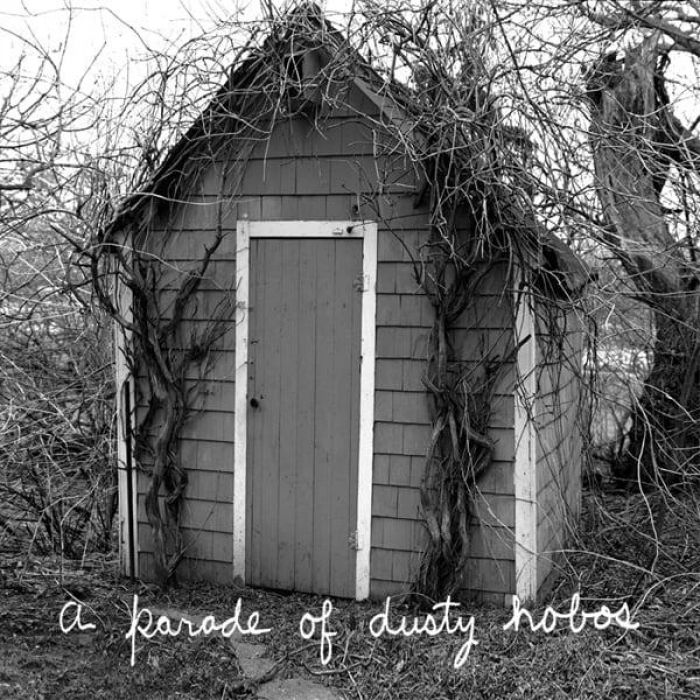A Parade of Dusty Hobos by Random Touch (Review)

When you truly listen to an album, when you sit down and start digesting it, it’s a two-way street. The album is interacting with you just as much you’re interacting with it — revealing new elements over time, taking you down new paths, etc. As melodramatic as that might sound, I’ve found it to be true over the years. Maybe not so much with pop/Top 40 music, which is often replicated as mere lowest common denominator entertainment, but as you move towards the avant-garde/experimental end of the spectrum, that music often demands time, energy, attention, and even commitment from the listener — or, in other words, a relationship.
Now I know that might sound odd, but think about your favorite albums. More often than not, you find them evolving over time. Even after you’ve listened to them for years, you’ll often discover some new element that you had somehow missed, or find that the music is relevant to your life in some brand new way. I know it’s happened to me on countless occasions, with albums mysteriously taking on a whole new aspect and bearing over time, sometimes for better and sometimes for worse.
That being said, perhaps it’s still too soon to tell just how I really feel about Random Touch’s A Parade of Dusty Hobos (the group’s fourth CD). But right now, as much as I want to enjoy the album, it seems insistent on holding me at arm’s length, dangling some tantalizing bit of sound before me only to toy with, and ultimately frustrate me. And although I’m trying to give it the benefit of the doubt, I’m quickly losing my patience.
Formed by Christopher Brown (percussion) and James Day (keyboards), who met in the mid-70s as members of the multimedia/performance art troupe Trusty Wourins Performance Ensemble (where the duo worked on the group’s visuals), Random Touch does bring a very eclectic and challenging range of sounds to the table — that much can be said for them. With self-proclaimed influences ranging from Jimi Hendrix and Herbie Hancock to Ligeti and Stravinsky, it’s not surprising that the duo, joined by long-time collaborator Scott Hamill on guitar, commits a staggering range of sounds, textures, and atmospheres to tape.
However, the result is not the heady rush of experimentalism and discovery one might hope for. Rather, it’s a mish-mash that finds the trio apparently trying to take their sound in as many directions at once, and the result is nothing short of a shambles. Which is a shame because there are some incredible moments on this disc, moments that could’ve been developed into some truly staggering songs if the trio had only exhibited a bit more patience and restraint. But more often than not, they subvert their own music, taking every single rabbit trail that appears rather than settling down and attempting to give their songs any sort of focus or cohesion.
The main culprit here is Day’s work on the keyboards. At times, he creates some intriguing sounds, such as the watery, Pete Namlook-esque ambience that serves as “Where We Come From“ ‘s undercurrent. However, his playing tends to be jarring, random (NPI), infuriatingly inconsistent, and completely out of step with everything else that’s going on in any given track.
Half the time, it just sounds like the studio cat somehow got into the recording room and walked all over the Kurzweil while everyone was out lunch. It’s maddening to hear some lovely atmosphere suddenly spoiled by a tumbling cascade of notes that comes completely out of left field. And making it even more annoying is that Day seems intent on using every single one of the preset sounds on his Alesis and Kurzweil synths — a little “Brass Trumpet” and “Slap Bass” here, a little “Space Flute” and “MoonRise” there, with no rhyme or reason. Sure, it adds a great deal of unpredictability and innovation to the album, but so much so that it completely loses touch with the listener.
Ironically, it’s Hamill (who isn’t even an official member of the group) that is responsible for the album’s most memorable moments, if only because he’s the only one that shows any sort of restraint. The long, aching guitar tones on “Slowing Down Time” sound like they’ve somehow survived days wandering through the Mojave Desert, all parched and choked with dust (think Labradford’s Mi Media Naranja, or A Small Good Thing). Hamill is somehow able to reign in the other two fellows as well, making this one of the album’s strongest tracks. Elsewhere, his fragile playing adds a keening, melancholy tone to “Somewhere Else Is Home,” another one of the disc’s finer moments.
When I first started listening to A Parade of Dusty Hobos, the music of Supersilent immediately came to mind. Both Supersilent and Random Touch have an air of invention and randomness (again, NPI) about their music, but the former possesses a sense of flow and grace, not to mention discretion, that is sorely lacking from the latter. Adding insult is the lengths to which Random Touch goes to convince you of just how experimental and out there they truly are, in case you didn’t quite get that impression from their music.
Statements such as “[Random Touch] are simultaneously regional and cosmic and reverent and comic. They are playfully high tech musicians and filmmakers, yet are ever ready to indulge the analog device, the child’s toy or the scrap of metal for whatever alchemy may arise. Serendipity, in all of its manifestations, acts as their friend.” abound throughout their website and press materials. It sounds impressive and arcane, but like the music, it gets so preposterous that the trio must be joking. If not, than “pretentious” doesn’t even begin to describe it.